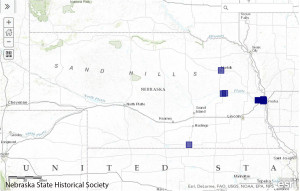
Jefferson County Courthouse, Fairbury. The city became a CLG in 2014.
Historic Preservation is at its core a local effort to protect those qualities that make communities unique and which tell important stories about the people and events that shaped them. The state historic preservation office helps Nebraskans discover these stories and share them with their neighbors and visitors. Still, the protection and management of historic places, sites, and objects depends upon those who live and work in and around them. In 1980, Congress revised the National Historic Preservation Act to allow communities a greater role in preservation and created the Certified Local Governments (CLG) program. The CLG program is a partnership between federal, state, and local governments designed to give towns, counties, and cities a direct role in the identification, designation, and preservation of their architectural and cultural heritage. The revised preservation act created a system where the states would pass through federal grants to help communities establish and maintain local historic preservation commissions, which would carry out the work of historic preservation within their jurisdictions. State historic preservation offices were required to pass through 10% of their federal grant money to communities that enacted a local historic preservation ordinance, established a historic preservation commission of at least 5 members, and designated a local historic preservation district. This program was opened to communities across the country, from large cities to small rural towns, and even entire counties. It allowed those communities to target those properties that were most important to them, and prevent the loss of buildings that otherwise lacked any protection.

Map of Nebraska Certified Local Governments. This certification gives towns, counties, and cities a direct role in the identification, designation, and preservation of their architectural and cultural heritage.
Nebraska CLG communities take the lead in local historic preservation. Auburn, Fairbury, Lincoln, North Platte, Omaha, Plattsmouth, Red Cloud and Sidney receive a combined total of over $110,000 in CLG grants every year to fund a variety of activities. In Omaha, CLG funds facilitated a new website, landmark.cityofomaha.org, as well as continuing survey efforts that constantly identify potentially historic buildings and neighborhoods. In Lincoln, historic preservation staff conducts an extensive public information campaign through guided tours and televised presentations on historic topics. Plattsmouth and Sidney developed design guidelines for owners of historic properties, and continue to survey their communities to develop up-to-date databases of their resources. Auburn and Fairbury established historic districts encompassing their 19th century downtowns. Red Cloud has partnered with the Willa Cather Foundation to carry out a project to further identify and document resources associated with the author’s writings within the town and in the surrounding county. All of these projects, and more, are a result of the partnership established by the CLG program.
Membership in the program provides other benefits outside of access to CLG grant funds. Training is available for commission members, either through the state historic preservation office, or by attendance at preservation-related conferences across the country. Communities are also eligible for technical assistance from the state in conducting a variety of preservation-related activities, including historic building surveys, historic nominations, and public outreach. Most important, the community is able to take the lead in the preservation and management of its resources. For more information on the CLG program, contact Ruben Acosta, NR and CLG Coordinator, [email protected]. – Ruben Acosta, (former) NR and CLG Coordinator
(Updated November 9, 2023) *For more information on the CLG program, contact Kelli Bacon, CLG Coordinator at [email protected].

2015 CLG Training. Jack Williams, the NAPC CAMP trainer, discusses design review with commissioners.



